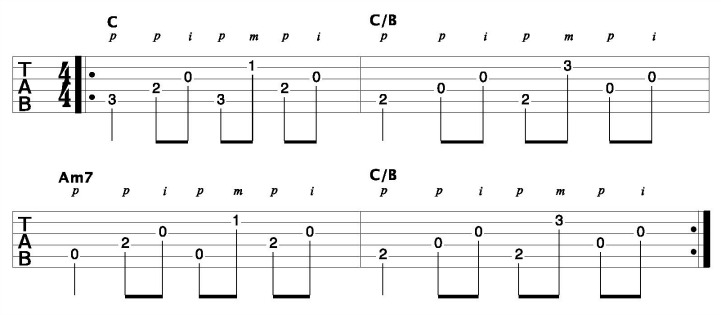How To Play Fingerpicking Guitar - 3 Common Acoustic Guitar Fingerpicking Patterns
Knowing how to play fingerpicking guitar opens up a whole new world of possibilities. If this approach is quite new to you, then it will help to have some guitar fingerpicking patterns under your fingers. This will not only develop and refine the technique for you, but learning some patterns for fingerpicking on your guitar will give you some practical applications you can use when applying this approach to your playing.
The great thing about fingerpicking is that it is not exclusive to any particular style of music. You will find fingerpicking guitar playing in a wide variety of music from rock to blues to jazz and country to name just a few. So, learning this style is something that you will benefit from time and time again as an acoustic guitar player.
1. Single Note Fingerpicking
The first pattern for fingerpicking on your guitar is a very common one. It involves picking single notes at a time, and you will find it in many songs. Here it is:

Notice that your thumb (p) is playing on the beat only. If you were to isolate the thumb you would be left with an alternating bass line. Breaking down a fingerpicking pattern like this helps to understand it and get it down.
The chord progression I am using here is a very common C to Am7 movement with a C/B chord connecting the two. This progression has formed the basis of many a song and sounds nice when we apply our fingerpicking patterns to it.
2. The Pinch Technique
The second pattern uses a “pinch” technique. One of the advantages of fingerpicking your guitar is that you can be very selective with the notes you want to play in a chord. Unlike when using a plectrum, it is very easy to play notes together that are not on adjacent strings in your fingerpicking patterns. This forms the basis of the “pinch” technique.
As you can see in the following example, I am “pinching” 2 notes out of each chord and following it with my index finger picking the open 3rd string.

If you have played or are familiar with the song “Blackbird” by The Beatles, then this pattern for fingerpicking may be familiar to you.
3. Breaking Up The Chord
The final guitar fingerpicking pattern I want to show you today has a very piano like sound to it. You could think of your thumb (p) as the left hand of a pianist and your fingers (i, m, a) as the right hand. The idea here is you are breaking up the chord by isolating the bass notes from the other notes in the chord.
Here it is:

As is the case with strumming, once you have a few common fingerpicking patterns under your fingers, you will be able to apply them to many different chord progressions in lots of different ways. In general, you will use a combination of the above patterns and approaches for your fingerpicking guitar songs.
I’ll leave you with an example of what I am talking about here.


New to fingerpicking? Check out these online lessons for fingerstyle guitar